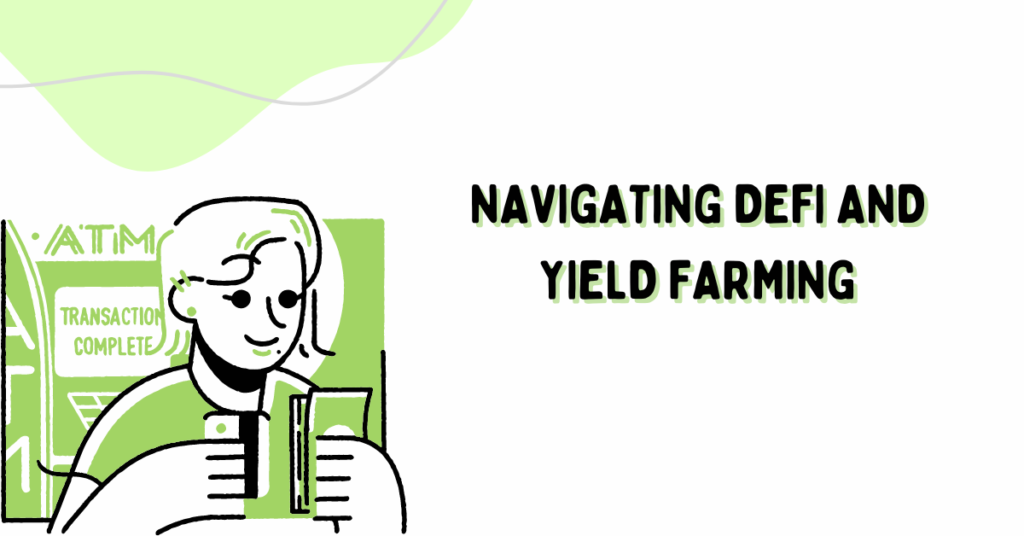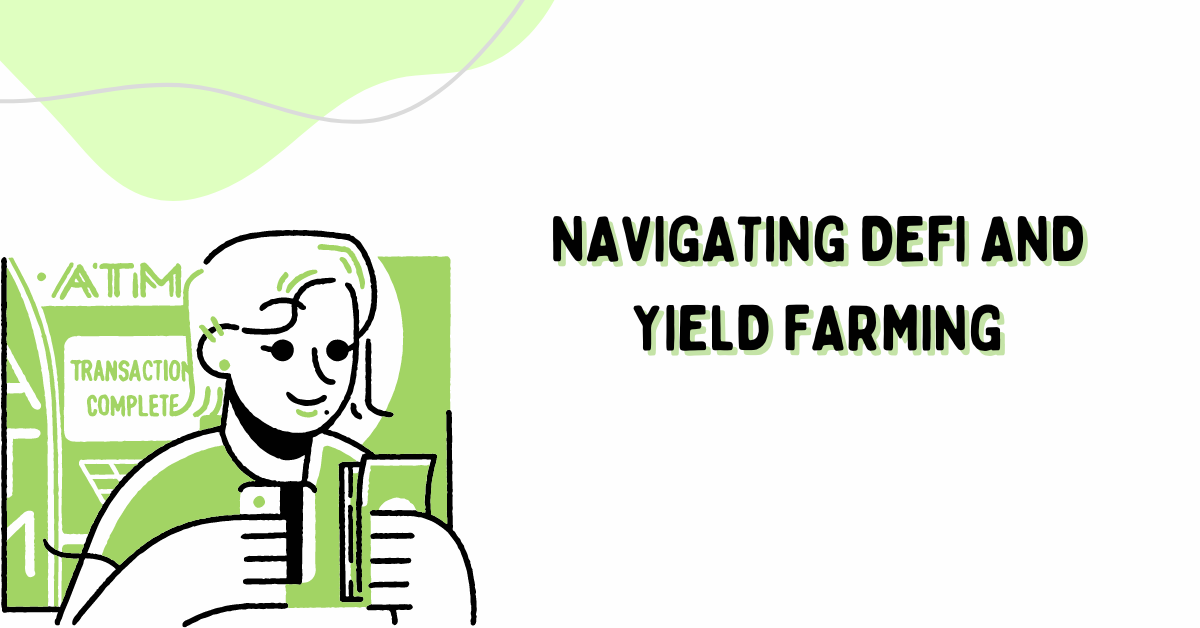Decentralized Finance (DeFi) has emerged as a revolutionary force in the world of finance, offering individuals unprecedented access to financial services and opportunities without the need for traditional intermediaries like banks or brokerages. Within the realm of DeFi, yield farming has gained significant traction as a strategy for generating passive income and maximizing returns on cryptocurrency holdings. In this guide, we’ll explore the fundamentals of DeFi and yield farming, discuss key concepts and strategies, and provide practical tips for navigating this exciting and rapidly evolving landscape.

Decentralized Finance (DeFi)
DeFi refers to a broad category of financial services and applications built on blockchain technology, primarily the Ethereum blockchain. Unlike traditional finance, which relies on centralized institutions to facilitate transactions and manage assets, DeFi operates in a decentralized manner, using smart contracts to automate processes and eliminate the need for intermediaries. This decentralized architecture offers several advantages, including increased transparency, accessibility, and security.
Key Features of DeFi
- Open Access: DeFi platforms are open to anyone with an internet connection and a compatible digital wallet, allowing users to access financial services from anywhere in the world without restrictions or barriers to entry.
- Permissionless Transactions: Users can interact with DeFi protocols without needing permission from a central authority, enabling seamless peer-to-peer transactions and financial activities.
- Transparency: DeFi transactions are recorded on a public blockchain, providing transparent and auditable records of all transactions and activities, enhancing trust and accountability within the ecosystem.
- Programmability: DeFi platforms are highly programmable, allowing developers to create sophisticated financial products and services using smart contracts, which are self-executing contracts with predefined rules and conditions.
Introduction to Yield Farming
Yield farming, also known as liquidity mining, is a DeFi strategy that involves providing liquidity to decentralized exchanges (DEXs) and other DeFi protocols in exchange for rewards, typically in the form of additional tokens or interest payments. The goal of yield farming is to maximize returns on cryptocurrency holdings by leveraging various DeFi protocols and strategies to earn passive income.
How Yield Farming Works
Yield farming involves several key steps:
- Providing Liquidity: Yield farmers provide liquidity to DeFi protocols by depositing their cryptocurrency assets into liquidity pools. These pools are used to facilitate decentralized trading on DEXs, allowing users to exchange assets without relying on traditional order books.
- Earning Rewards: In exchange for providing liquidity, yield farmers receive rewards in the form of additional tokens, transaction fees, or interest payments. These rewards are distributed based on the amount of liquidity provided and the duration of participation in the protocol.
- Optimizing Returns: Yield farmers can optimize their returns by strategically allocating their assets across different liquidity pools, and adjusting their positions based on factors such as yield rates, token prices, and market conditions.
Strategies for Yield Farming
Yield farming encompasses a wide range of strategies and techniques designed to maximize returns and minimize risks. Some common yield farming strategies include:
- Liquidity Provision: Providing liquidity to decentralized exchanges (DEXs) and automated market maker (AMM) protocols such as Uniswap, SushiSwap, and PancakeSwap to earn trading fees and liquidity mining rewards.
- Yield Aggregation: Maximizing returns by leveraging yield aggregators such as Yearn.Finance and Harvest Finance, which automatically allocate funds to the most profitable yield farming opportunities across various DeFi protocols.
- Staking: Staking involves locking up cryptocurrency assets in a smart contract to support the operations of a blockchain network and earn staking rewards. Platforms like Ethereum 2.0, Cardano, and Polkadot offer staking opportunities for users to earn passive income.
- Lending and Borrowing: Participating in decentralized lending and borrowing protocols such as Compound and Aave to earn interest on deposited assets or borrow funds against collateralized assets.
Risks and Considerations
While yield farming can be highly lucrative, it also carries inherent risks and considerations that investors should be aware of:
- Impermanent Loss: Providing liquidity to AMM protocols exposes investors to the risk of impermanent loss, which occurs when the value of deposited assets diverges from the value of assets held in the liquidity pool.
- Smart Contract Risk: DeFi protocols are powered by smart contracts, which are susceptible to coding errors, vulnerabilities, and exploits. Investors should conduct thorough due diligence and assess the security of protocols before participating in yield farming.
- Market Volatility: Cryptocurrency markets are highly volatile, with prices subject to rapid fluctuations and unpredictable movements. Yield farmers should be prepared for market volatility and consider strategies to mitigate potential losses.
- Regulatory Uncertainty: The regulatory landscape surrounding DeFi and yield farming is still evolving, with regulatory authorities worldwide scrutinizing the sector for compliance with existing financial regulations. Investors should stay informed about regulatory developments and assess the legal and compliance risks associated with participating in yield farming.
Tips for Navigating DeFi and Yield Farming
- Start Small: Begin with small investments and familiarize yourself with the mechanics of DeFi and yield farming before committing significant capital.
- Diversify Your Portfolio: Spread your investments across different DeFi protocols, assets, and strategies to minimize risk and optimize returns.
- Stay Informed: Stay up-to-date with the latest developments, trends, and news in the DeFi space through reputable sources such as industry publications, forums, and social media channels.
- Practice Risk Management: Set clear investment goals, establish risk management strategies, and only invest what you can afford to lose.
- Seek Professional Advice: Consider consulting with financial advisors, blockchain experts, or DeFi specialists for personalized guidance and advice on navigating the world of DeFi and yield farming.
Conclusion
Decentralized finance (DeFi) and yield farming represent exciting opportunities for individuals to participate in innovative financial services and earn passive income with their cryptocurrency holdings. By understanding the fundamentals of DeFi, exploring different yield farming strategies, and exercising caution and due diligence, investors can navigate this dynamic and rapidly evolving landscape and capitalize on the potential benefits of decentralized finance.
Remember to start small, diversify your portfolio, stay informed, practice risk management, and seek professional advice when needed. With the right knowledge, strategies, and mindset, you can successfully navigate the world of DeFi and yield farming and unlock new possibilities for financial growth and prosperity.



Hello
Thank You So Much For All Articles.
Thanks
2.3.24